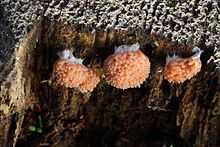Hypothallus

The hypothallus is a hat-like layer on true slime molds, the myxogastria, on which the fruit body is sitting and which displays the connection of the fruit body to the underground. Roughly translated it means "under the thallus".
The hypothallus is produced by the plasmodium at the beginning of the fructification. Depending on the species, it can be membranous to thick or tender to solid and nearly transparent to radiant coloured. It is either shaped isolated as an edge of single fruit bodies or as a permanent layer, which connects the edges of numerous fruit bodies. In some but rarely cases it is missing entirely.[1]
Depending on the taxon, it is directly involved in the further fruiting of the fruit body: the Stemonitida is caused by the so-called "epihypothallic". Here, the hypothallus becomes a hollow, tubelike stem (and in consequence also a columella);[2] this trinity produces a morphologic object. On the stem or the columella rises the remaining plasmodium and produces a separate structure, which carries the spores.[3]
On all other myxogastria, however, a "subhypothallic" development takes place. Here, the hypothallus produces a layer on the plasmodium, which creates the rooms of the single fruit bodies during fruiting. As the surrounding plasmodium flows in the fruit body, the hypothallus will lie directly on the substrate, shrinks and creates the edge of the mature fruit body. The hypothallus is here part of a morphologic unit with peridium and stem, which serves as a membranous surface of the whole structure with the spores.[4]
The epihypothaly is an autapomorphy of the stemonitida and is, compared with the subhypothaly, a primitive feature.[5]
References
- ↑ Reference for the paragraph: Henry Stempen, Steven L. Stevenson: Myxomycetes. A Handbook of Slime Molds. Timber Press, 1994, ISBN 0-88192-439-3, p. 26.
- ↑ Wolfgang Nowotny: Myxomyceten (Schleimpilze) und Mycetozoa (Pilztiere) - Lebensformen zwischen Tier und Pflanze In:
- ↑ Reference for the paragraph: A.-M. Fiore-Donno, C. Berney, J. Pawlowski, S.L. Baldauf: Higher-Order Phylogeny of Plasmodial Slime Molds (Myxogastria) Based on Elongation Factor 1-A and Small Subunit rRNA Gene Sequences. In: Journal of Eukaryotic Microbiology, 52, pp. 201–210, 2005
- ↑ Reference for the paragraph: Wolfgang Nowotny: Myxomyceten (Schleimpilze) und Mycetozoa (Pilztiere) - Lebensformen zwischen Tier und Pflanze In:
- ↑ A.-M. Fiore-Donno, C. Berney, J. Pawlowski, S.L. Baldauf: Higher-Order Phylogeny of Plasmodial Slime Molds (Myxogastria) Based on Elongation Factor 1-A and Small Subunit rRNA Gene Sequences. In: Journal of Eukaryotic Microbiology, 52, pp. 201–210, 2005